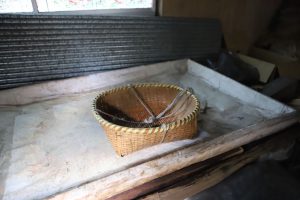MENU
MENU
Tea production area: Rikuzentakata City and Ofunato City
Brand name of tea: Hiyama tea
Types of tea: Sencha (medium steamed green tea)and black tea
Tea cultivation began as a countermeasure to poverty for the samurai
It is thought that Tagaya Minemitsu, the 21st head of the Tagaya family of Hiyama territory, brought tea seeds from Uji. The seeds were planted around 1730 of the Edo period, and this was the beginning of Hiyama tea.
It is said that tea cultivation was recommended as a countermeasure to the samurai’s poverty due to the Tenpo Famine. At that time, about 200 samurai families were cultivating tea.
When the Meiji Period began, and samurai society came to an end, many samurai who cultivated tea left Hiyama. Also, during World War II, cultivating tea changed to planting potatoes and beans due to food shortages.
As a result, the number of people who grew and made tea decreased.

Tea fields of Hiyama Otaka chaen (Hiyama Otaka tea garden) (November 2018)
People who have preserved Hiyama tea
Kajiwara seicha cultivates and produces sencha and black tea, and Hiyama Otaka chaen (Hiyama Otaka tea garden) cultivates and produces sencha. They produce tea by hand without a machine.
Ms. Keiko Kajiwara has made Hiyama tea for more than 20 years, since she first helped her uncle’s tea garden “Kajiwara chaen”. She is the chairperson of the Hiyama Tea Preservation Society. The society holds events such as experiences of tea-picking and manual tea processing to let more people know about Hiyama tea. She rents land on the slope of the mountain near the ruins of the Hiyama Castle and cultivates tea with members of society.

Chaseido’s chayokan using Hiyama tea and hand-rolled Hiyama tea (sencha)
Yokan with Hiyama tea
Chaseido, which is run by Mr. and Mrs. Kajiwara, produces and sells yokan with Hiyama tea. The yokan was designed by her father in 1960 and has Hiyama tea flavor.

Hiyama tea yokan which are sold at Higashi Noshiro Station (October 2018)

Kajiwara seicha’s hand-rolled black tea

Hiyama Otaka chaen (November 2018)

Hoiro and basket at Hiyama Otaka chaen (November 2018)
Hand-rolled tea are made using hoiro and basket.
*Hoiro is a dryer for tea leaves using a heat source for making tea by hand-rolling. Steamed tea leaves are rolled by hand on the hoiro
Hoiro looks like a dining table, and a Japanese paper is pasted on the top surface. A heat source is placed inside of hoiro, and it heats up on the surface. Previously/Historically the heat source was charcoal fire, but now gas is used.
*Yokan is a Japanese traditional sweet which is a type of sweet azuki bean jelly.
Related article on the site:
Tea related facility:
Yuru-Chara (mascot character) related tea:
Ceramic and pottery art: Naraoka ware and Shiraiwa ware
Reference:
松下智 (平成3年) 日本名茶紀行 (初版) 雄山閣出版
高野實、谷本陽蔵、富田勲、中川致之、岩浅潔、寺元益英、山田新市 執筆 (社)日本茶業中央会監修 (2005) 緑茶の事典 改定3版 柴田書店
*The information provided on this site may be updated. If you find any information in this article that is incorrect, new, or incomplete, please contact CHAMART.
*The site does not describe all “Teas of Japan” or all “Teas of the World”. Additionally, each article expresses the writer’s personal experience and feelings.
#hiyamatea #japanesetea